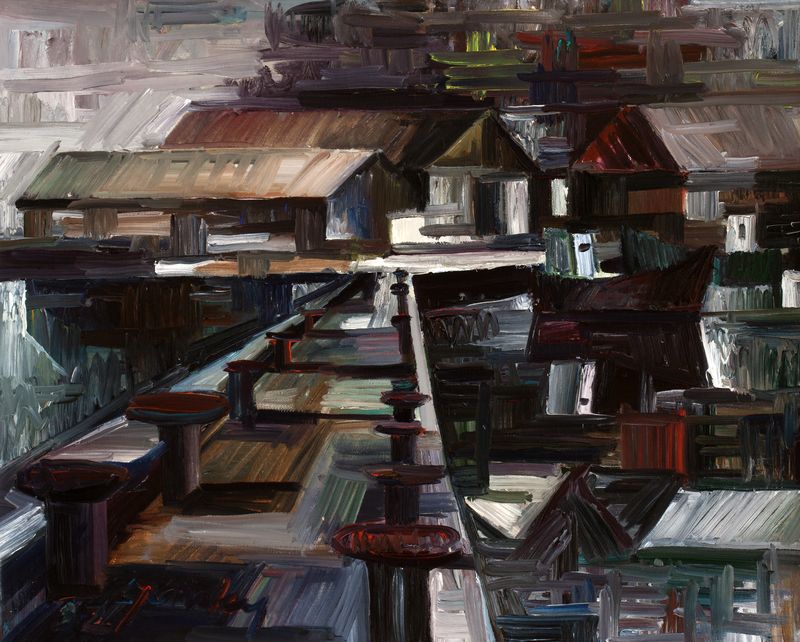Linas Julijonas Jankus. Visions of Light and Colour
9 June-25 September 2022

The Pamario Gallery in Juodkrantė is holding an exhibition of landscapes of the Pamarys region by the painter Linas Julijonas Jankus from the collections of the Lithuanian National Museum of Art. Rendered in bluish-grey tones, the compelling motifs of Dreverna, Rusnė, Rasytė, Pjauliai, Mingė, Nemunynas, Gilija and other places are showcased in constructive compositions that use varied view angles. The colder colour palette and especially expressive brush strokes are eye-catching. The exhibition features landscapes from the 1970s and 1980s that reveal the development of the artist’s creative language and his close ties to the locations depicted in a concentrated and appealing manner.
The water, ships, boats, houses and canals in Pamarys serve as motifs in Jankus’s paintings. The artist immersed himself in the environment and nature of the region and befriended the people who lived there. In painting, he discovered light – a tool employed by many artists. The sun and its light, the shimmering water surrounded by trees and meadows became the main motifs of his paintings. Jankus discovered a meaningful expression of light that prompts reflection on the fate of man and nature. The painter has said: “The place where you live and the impressions you have in your childhood become deeply imprinted in your consciousness. From the shoulders of my father, Stasys Jankus, I saw the Dreverna pier full of sailboats, as well as Rusnė, Kintai, Mingė, Juodkrantė and Ramybas. It all became the subject of my work.” The locations of his father’s birthplace, familiar since childhood, linked the artist’s experiences with this region emotionally. The painter visualised the motifs of Pamarys region through his own distinctive plastic expression, evocative brushstrokes, streams of light, contrasting colours and a code of accentuated imagery. The piers and bays with boats and houses by the water, painted using the alla prima method show the artist’s efforts to grasp the ever-changing moods of nature and the flickering light in various seasons.
Jankus believed in the idea of the beauty of nature and sought to convey it through his own aestheticized language of painting grounded in the expression of light and colour. Jankus’s early paintings from the 1970s are based on improvisations in colour and light, reminiscent of the works of the Impressionists (In Dreverna, 1975; At the Dreverna Pier, 1976). Later paintings from the 1980s are more constructive, akin to the Post-Impressionists. Of course, his eye for nuanced colour also hints at the works of his teacher, the master of subtle landscape, Algirdas Petrulis, while the constructive compositions and bursting accents of bright colours reference Jonas Švažas. The works are characterised by clear form and emphasised constructive accents: the outlines of a pier or the coastline, the silhouettes of boats and little houses. (Pier, 1982; Gilija, 1981; Homestead in Mingė; Pier in Rasytė).
The colour palette of Jankus’s paintings is memorable thanks to its deep, muted tones, cold greyish blues, greens and purples. They are contrasted by bright streaks of white, yellowish and blueish brushstrokes. His painting language was also influenced by the fact that in 1999, the artist, as a native of Vilnius, moved to the village of Pjauliai, where he drew profound and meaningful inspiration for his work, being enveloped by nature and taking walks in the surrounding area or sailing in the Curonian Lagoon in a traditional kurėnas sailboat he had made himself.
Jankus was born in 1946 in Priekulė and died in 2014, also in Priekulė. He studied painting in the Faculty of Pedagogy of the Lithuanian Institute of Art in 1964‒1969 (taught by Jonas Švažas and Algirdas Petrulis). Since 1970, he participated in exhibitions in Lithuania and abroad and held close to 20 solo exhibitions. He was a member of the Lithuanian Artists’ Union’s Association of Young Artists since 1969 and of the Lithuanian Artist’s Union since 1978. He was also a member of the Volunteer Artists Union of the Lithuanian Armed Forces. He has written memoirs and exhibition reviews. He taught art in various higher education schools in Lithuania: Vilnius University and Vilnius Gediminas Technical University; was a professor and the head of the Department of Art at the Faculty of Art of the Klaipėda University. Since 2009, he was the chairman of the Klaipėda Region Branch of the Council for the Affairs of Lithuania Minor.
Curator Nijolė Nevčesauskienė
Supported by Neringa Municipality
3 L. Rėzos st, LT-93101, Juodkrantė, Neringa, Lithuania.
+370 469 53 323, +370 46 410 412
pamario.galerija@lndm.lt













